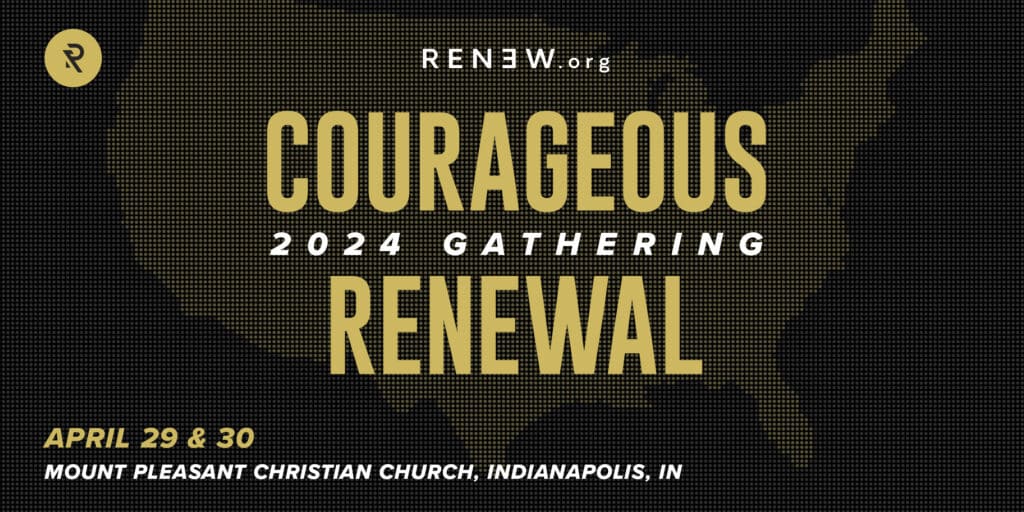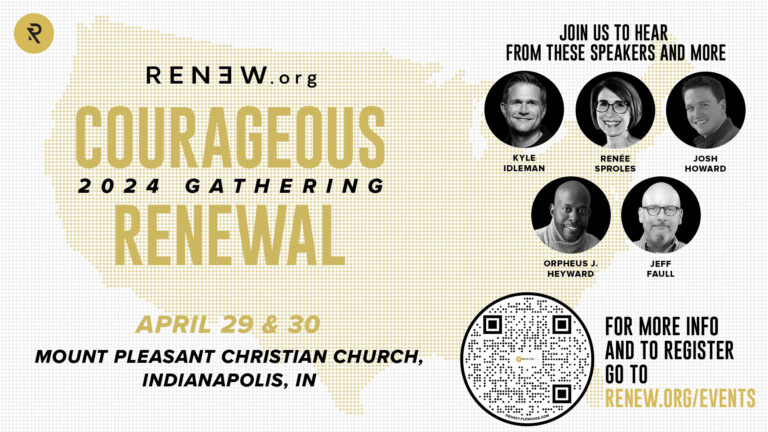*Editor’s Note: Can Disciple Making Movements (DMM’s) happen in North America? Recently, I got to chat with Paul Huyghebaert, one of RENEW.org’s associate directors of learning communities and the senior minister of Grace Chapel Church of Christ in the Atlanta area. Paul has been facilitating some exciting DMM conversations between global DMM leaders and North American church leaders. One of these conversations will take place at the RENEW.org Gathering in Indianapolis on the evening of Tuesday, April 25, where you can interact with him and Shodankeh Johnson about DMM possibilities for North American churches. Paul and Shodankeh will also be teaching a breakout session on Wednesday for the RENEW.org Gathering, followed by a 4-part RENEW.org track on DMM’s and the North American church at Discipleship.org’s National Disciple Making Forum on Wednesday and Thursday. In the following conversation, Paul talks about exciting possibilities, common obstacles, and upcoming opportunities.
Q. The stories we’re hearing about “Disciple Making Movements” around the world can sound too good to be true. Was there a time when you were skeptical of Disciple Making Movements (DMM’s)?
Yes, when I first began hearing the stories about DMM’s from other people who had heard the stories, I was skeptical. And there’s a second layer of skepticism too that I’ve wrestled with. It’s the idea that, sure, DMM’s might be happening “over there,” but I doubt it could happen over here. We’re just living in too different of a culture.
Q. For you, what changed regarding the first layer of skepticism?
It was when I started to engage with global DMM leaders themselves that I began to be convinced that God was truly doing something. I saw the pictures, saw the evidence, heard the firsthand experiences.
I’ve become friends with some of the Christian leaders who lead DMM’s in the global South. I’ve gotten to know Curtis Sergeant, Shodankeh Johnson, Josh Howard, Bill Smith, Will Smith. These are honest guys; they’re not making things up. It really challenges your skepticism when you do more than just read about the movements—when you learn that these DMM principles play an everyday part of their ministries and their lived experience.
Q. What exactly is a Disciple Making Movement?
Here is a helpful description of what we’ve been seeing which have come to be known as Disciple Making Movements:
A rapid and exponential increase in disciple-making disciples (1,000 or more) within a local culture who plant multiple churches, and these churches are churches who multiply disciples, groups, and churches of obedience-based disciples so that we can see at least four generations of churches produced in six streams of disciple-making activity and these streams multiply consistently into churches (100 churches or more within 2 to 5 years).
Q. So, do you honestly think it’s possible for what we’re seeing “over there” to happen over here?
We are seeing evidence that Disciple Making Movements can indeed happen here. I’ve started regularly engaging with North American churches which are implementing DMM principles and we’re starting to see traction. We continue to learn from each other, sharpen each other, and encourage each other, and it has been so encouraging to get a front-row seat to this collaboration.
Yes, there can be difficulty, hesitancy, skepticism. In the churches being led into these principles, the people have at least the same number of reservations as we had starting out. Often, they’re trying to embrace the principles without seeing what we, who have spent time with DMM leaders, have gotten to see. For many, it feels like an entirely new set of practices. And yet, if the people in your churches are at least getting to the place where they say, “We believe that you believe it,” that’s a major first step of buy-in, and it’s worth celebrating.
“If the people in your churches are at least getting to the place where they say, ‘We believe that you believe it,’ that’s a major first step of buy-in.”
Q. In your experience, how interested are North American church leaders in these principles?
Not too many years ago, there seemed to be just a few North American voices calling for a shift toward disciple making. Now, countless churches are talking about making this shift. In my role at RENEW.org, at this time we are working with over 30 North American churches which are at various levels of implementing these DMM principles. We’re seeing each, in their own unique way, contextualizing some of the DMM principles, and we are hearing their stories of genuine traction. We’re witnessing a cultural shift in some influential churches.
Personally, through my connection with RENEW.org and Discipleship.org, I have been receiving more and more phone calls and emails from people curious about how DMM principles can influence their churches. I know this is anecdotal, but without a doubt, I’ve seen a higher level of curiosity and desire about DMM’s among North American church leaders than at any other time.
Q. What has been the first layer of curiosity?
Many church leaders, especially post-Covid, are realizing there are some significant weaknesses in many of our current structures and methods. Especially when it comes to making lifelong disciples of Jesus. We’re recognizing that in some ways we’re living in a different world, and it’s a good time to revisit and recommit to Jesus’ Great Commission.
Q. What gets in the way?
It can be helpful to think in terms of fears and fixtures. The two go together, since we tend to be afraid of changing our fixtures, especially the longer a church’s history of doing things a certain way. Sure, there are going to be people willing to go first in adopting something new, but the majority of people will be hesitant, waiting to see if the change is worth it.
One fear can be that, by adopting new disciple-making principles, we might be dishonoring a previous generation and downplaying their efforts. But we can totally move forward, for example, past a more attractional, seeker-sensitive model, while still being complimentary of the good done in those years (e.g., seeker-sensitive churches brought a lot of people into church). But the temptation is to think that, when something once worked, we just need to do it better and it will work again. But that’s not often the way it works.
Another fear is that we will have to relinquish our dependence on our strategies, because of DMM’s radical reliance upon the Holy Spirit. The truth is, however, these DMM leaders are incredibly strategic. But their strategy begins with prayer and fasting because of the need to rely so heavily on the Holy Spirit’s leading. In the North American church, we tend to lean our reliance more upon the new strategy in the latest book we read than on really pausing to pursue the Holy Spirit’s leading. Of the 8 principles that characterize DMM’s, there’s a reason radical dependence upon the Holy Spirit tops the list.
“These DMM leaders are incredibly strategic. But their strategy begins with prayer and fasting.”
A final fear I’ll mention is that it can feel unnerving for church leaders to envision ministry in which it’s not the professionals that do the majority of the work. Ordinary, everyday people of all professions are the ones moving these movements forward. That’s attractive, but it’s also different. Is it wise to entrust non-professionals with discipling new believers? vocational ministers might wonder. And what might it mean for my job? The truth is, there is still a place within DMM’s for vocational ministers, for large gatherings, and for robust theological education. But I understand the hesitation when there’s the perception that livelihood could be at stake.
Q. If a church transitions from being an “attractional church” to a “disciple-making church,” does that mean that the production quality goes down (e.g., for weekend services)?
At RENEW.org and Discipleship.org, we are adopting a posture of hybridity. We’re acknowledging good things in the contemporary, “legacy church” experience. The downfall is not that people come and experience a high-quality worship service. The downfall is when a church’s emphasis rarely goes beyond “Come and see what we’re doing here.” An “attractional church” places its highest value on what happens at the building, whereas what we’re trying to instill is a higher value in “go and be” rather than “come and see.”
Let’s be clear. We are not encouraging churches to be unattractive. We encourage people to put forward the best church service possible and pursue excellence to the glory of God. We’re most certainly not asking people to throw all production out the window. But we want to call people to something so much more than just the Sunday morning experience. We want to make disciples who are disciples who make disciples all throughout the week.
Q. What are some Scriptures that fuel your hope and efforts for seeing Disciple Making Movements in North America?
I’ll give you the three Scriptures I pray on a daily basis, patterned on my interactions with DMM leaders. Over time, praying these Scriptures has changed me.
At 10:02 a.m., I pray Luke 10:2—that Jesus would send out workers into the harvest. We often assume the harvest in our day and context is not plentiful, but I trust that verse applies in our day as well.
At 4:36 p.m., I pray Colossians 4:3-6:
“And pray for us, too, that God may open a door for our message, so that we may proclaim the mystery of Christ, for which I am in chains. Pray that I may proclaim it clearly, as I should. Be wise in the way you act toward outsiders; make the most of every opportunity. Let your conversation be always full of grace, seasoned with salt, so that you may know how to answer everyone.” (Col. 4:3-6, NIV)
“Pray for us, too, that God may open a door for our message.”
I pray that God would open doors for the gospel and that I would make the most of every opportunity that day. It’s amazing the significance every opportunity can take on when this is my mindset.
From 4:24-4:30 a.m., I’ll wake up and pray for 6 minutes, sometimes longer, the prayer in Acts 4:24-30. In particular, I pray that God would enable us to “speak your word with great boldness” and that he might “perform signs and wonders through the name of your holy servant Jesus” (Acts 4:29-30, NIV). We need to see God move in power again. We need to be bold in our convictions and in sharing them, and sometimes it requires praying for that boldness. When the early church prayed that, they saw the movement and power of God.
I’m certain there are many other Scriptures that can be equally formative. But I’m coming up on two years of regularly praying these three. Through these prayers, I’m acknowledging dependence on God and expressing it in an unashamed begging. It’s going to that friend and knocking and continuing to knock on the door in a way that might otherwise make us feel embarrassed. But we want God to move in power badly enough and continue to trust God that he is going to give us this good thing. We want to see revival in North America in our day.
“Through these prayers, I’m acknowledging dependence on God and expressing it in an unashamed begging.”
Q.Tell us about the upcoming events you’re involved with in the two conferences coming up in Indianapolis (Renew.org and Discipleship.org).
Tuesday evening, April 25, is the official start of the RENEW.org National Gathering. On Tuesday evening, we will be creating space for people to interact with each other. There will be twelve rooms to choose from, each dedicated to a contemporary issue that churches are facing. One of the twelve will be focused on “Disciple Making Movement Principles for Your Church,” and Shodankeh Johnson and I will be facilitating conversation in that room. We will be interacting about Disciple Making Movements and how they can be contextualized in North American churches.
RENEW.org has always been more than just resources and events. At heart, we are a network of people encouraging each other toward faithful and effective disciple making. The network is built out of these relationships, and Tuesday evening will be part of acknowledging that we’re walking similar paths, facing similar issues, and hoping to help each other walk more faithfully.
The RENEW.org Gathering continues through Wednesday, April 26, until 4:00 p.m. with TED-style talks, worship, prayer, and discussion time. On Wednesday, Shodankeh Johnson and I will be teaching a breakout on DMM’s.
Then, during Discipleship.org’s National Disciple Making Forum (April 26-27), I will be facilitating a 4-part RENEW.org track on DMM’s and how they relate to the North American church. In these track sessions, we will be engaging with three globally recognized DMM leaders: Shodankeh Johnson, Curtis Sergeant, and Josh Howard.











